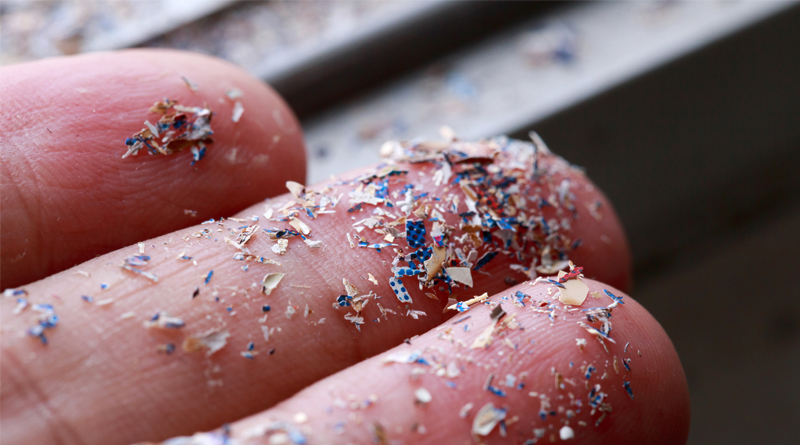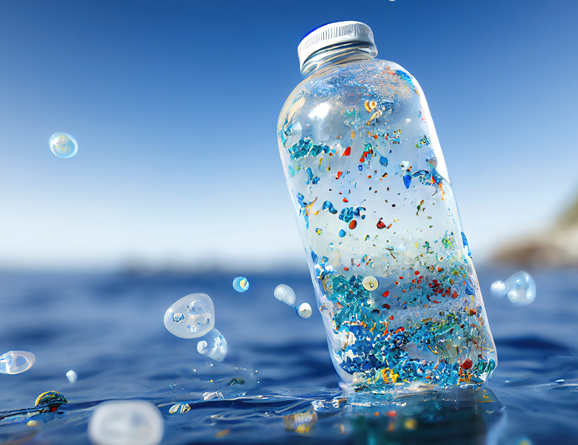Nanoplastics: Can we hide from the threat?
By: Maria Alejandra Pulgar
Plastics are everywhere in our lives. The invention of plastics at the beginning of the 20th century represented a breakthrough for innumerable processes around the world. The creation of these synthetic materials revolutionized industries and improved the lives of people.
But at that time, nobody thought about what would happen with those disposable materials once they were no longer in use. Fast forward 100 years, and here we are, with not only landfills full of tons of plastic but also an environment full of particles of substances so tiny that there is no way to get rid of them. Their impact on the environment and human health is undeniable; they are the subject of a great number of studies around the world and the target of several U.N. goals for a sustainable world.
 Microplastics are small pieces of any type of plastic material measuring less than five millimeters long, while nanoplastics are particles measuring less than 100 nanometers, which is less than a human hair. While some have been created with a specific purpose, most of them are the result of the degradation of larger plastic waste after being exposed to environmental factors. Washing synthetic clothes, abrasion of car tires while driving, incineration of plastics in landfills, or weathering of plastics left in the outdoors are all ways that micro and nanoplastics enter the environment.
Microplastics are small pieces of any type of plastic material measuring less than five millimeters long, while nanoplastics are particles measuring less than 100 nanometers, which is less than a human hair. While some have been created with a specific purpose, most of them are the result of the degradation of larger plastic waste after being exposed to environmental factors. Washing synthetic clothes, abrasion of car tires while driving, incineration of plastics in landfills, or weathering of plastics left in the outdoors are all ways that micro and nanoplastics enter the environment.
They enter natural ecosystems through different sources, like cosmetics or industrial processes, but getting rid of them is no easy task. At this point, we need to focus on prevention and avoidance, because rolling back the damage that has been done to the environment with plastics, though not impossible, will take great time, talent, and treasure from individuals and governments alike.
We can run, but we cannot hide.
The convenience of the use of plastics has become a blessing and a curse at the same time. As an example, think for a moment of a mother in the 1950s caring for her babies with glass bottles and cloth diapers. With disposable materials, daunting tasks that took a great deal of time to be completed became obsolete, giving people more time to devote to other activities, to join the workforce, or to develop new processes that supported the fast evolution of the world in the 20th century. However, evolution has left its mark on the environment, and now we are dealing with the consequences.
 While primary microplastics were developed to be small enough to be used in products like facial scrubs or toothpaste, secondary microplastics are the result of the degradation of larger plastics, which are discarded and exposed to environmental factors or waste management processes.
While primary microplastics were developed to be small enough to be used in products like facial scrubs or toothpaste, secondary microplastics are the result of the degradation of larger plastics, which are discarded and exposed to environmental factors or waste management processes.
Microplastics have been found in marine environments worldwide and can carry toxic chemicals that accumulate in the food chain. When animals ingest those microplastics, the toxins can be transferred to other organisms and ultimately to humans. Some microplastics have been shown to concentrate pollutants from seawater, creating even more hazardous conditions for the environment.
Nanoplastics, microplastics’ smaller “siblings,” appear as the result of the environmental degradation of plastic materials or as the residue of industrial processes. They are so tiny that they can travel long distances, infiltrate other environments more easily, and penetrate cells and tissues in living organisms; they have been detected in air, snow, soil, and seawater. Recent studies published by the National Center for Biotechnology have discussed the finding of nanoplastics in human blood, liver and lung cells, and reproductive tissues. Their size and potential impact constitute a unique challenge for scientists looking for ways to control their prevalence in the environment.
Proactivity is key to preventing risks.
What can be done? Is humankind doomed to succumb to plastic poisoning? The future is not that somber, but especially in more developed countries, people need to take the lead and embrace proactive initiatives to reduce and prevent the increase of microplastics and nanoplastics pollution worldwide.
The complete avoidance of microplastics can be difficult, but it can be prevented with simple measures such as: choosing natural products as an alternative to cosmetics with microbeads; favoring clothing made from natural fibers to reduce microplastic shedding when washing them; supporting bans on single-use plastics; organizing clean-up campaigns on public ways or beaches; or advocating for recycling and reusing and for better waste management systems that prevent plastic leakage into the environment.
However, any individual initiative to correct the plastic waste problem for the environment cannot be effective without governments and industries that implement policies that support the reduction of plastic production and use or without investments in research to find new materials less damaging to the environment.
The first two decades of the 21st century have led to more worldwide awareness about the impact of microplastics on the environment and human health. Studies in Asia, Europe, and the U.S. have investigated the effects of plastic pollution, increasing concern about the issue and the need to prevent and correct it.
The concern for microplastics and nanoplastics as a threat to the environment and, in consequence, to human health, far from being a source of fear, should be a wake-up call to collectively take ownership of our responsibility to do our part to care for the environment. As we move towards the UN’s 2030 target, the actions we take today will determine the legacy we leave for future generations. The path forward is clear: reduce, innovate, and collaborate to preserve a healthier planet for our future generations.

